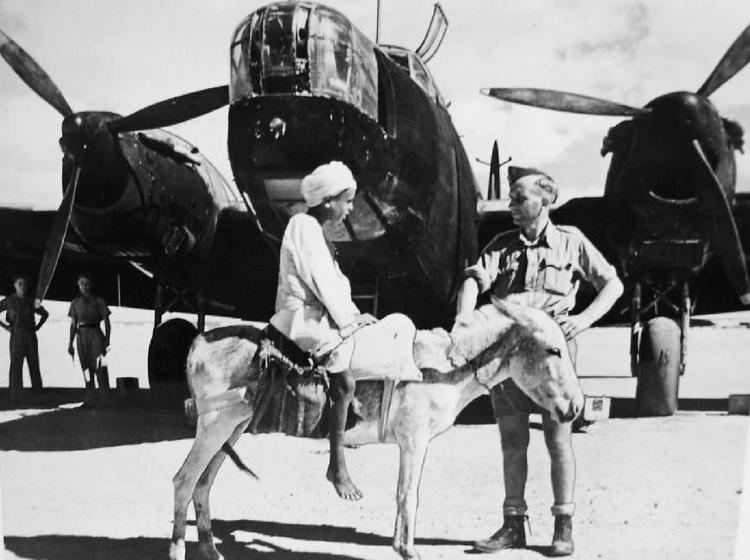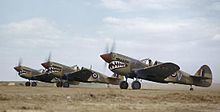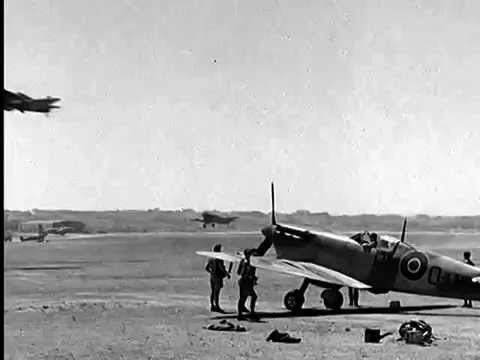Allegiance Allies Garrison/HQ Cairo(?) Headquarters Cairo Engagement World War II | Engagements World War II Founded 21 October 1941 | |
 | ||
Size over 1,500 combat aircraft (late 1942) Similar RAF Second Tactical A, South African Air Force, Balkan Air Force, Jagdgeschwader 27, RAF Fighter Command | ||
British desert air force history ww2
The Desert Air Force (DAF), also known chronologically as Air Headquarters Western Desert, Air Headquarters Libya, the Western Desert Air Force, and the First Tactical Air Force (1TAF), was an Allied tactical air force created from No. 204 Group under RAF Middle East Command in North Africa in 1941 to provide close air support to the British Eighth Army. Throughout World War II, the DAF was made up of squadrons from the Royal Air Force (RAF), the South African Air Force (SAAF), the Royal Australian Air Force (RAAF), the United States Army Air Forces (USAAF) and other Allied air forces.
Contents
- British desert air force history ww2
- No 249 squadron raf spitfire v serial ep829 t n 28 april 1943
- History
- AHQ Egypt
- Western Desert Air Force
- Allied restructuring
- Aircraft
- Personnel
- Commanders
- References
In October 1941, the Western Desert Air Forces had 16 squadrons of aircraft (nine fighter, six medium bomber and one tactical reconnaissance) and fielded approximately 1,000 combat aircraft by late 1941. By the time of the Second Battle of El Alamein, the DAF fielded 29 squadrons (including nine South African and three USAAF units) flying Boston, Baltimore and Mitchell medium bombers and Hurricane, Kittyhawk, Tomahawk, Warhawk and Spitfire fighters and fighter-bombers. There were over 1,500 combat aircraft, more than double the number of aircraft the Axis could field.

No 249 squadron raf spitfire v serial ep829 t n 28 april 1943
History

Prior to the establishment of the Desert Air Force, several RAF formations operated in North Africa. On 3 September 1939, RAF Middle East Command—under Air Chief Marshal Sir William Mitchell, Air Officer Commanding-in-Chief Middle East—comprised four separate commands: for Egypt (designated Middle East), RAF Iraq, Mediterranean at Malta, and RAF Aden (No. 8, No. 203, and No. 94 Squadrons). Mitchell handed over to Air Vice Marshal Sir Arthur Longmore in early May 1940. When Italy declared war in June 1940, Longmore had just 29 squadrons numbering less than 300 aircraft – dispersed across the four commands detailed above.
AHQ Egypt

On 10 June 1940, RAF bomber squadrons in AHQ Egypt—under the direction of No. 202 Group RAF—totalled five squadrons of Bristol Blenheims, one of Vickers Valentias and one of Bristol Bombays. The Valentia and Bombay could either be used as troop transports or medium bombers.


AHQ Sudan had 254 Wing with No. 14, No. 223, and No. 47 squadrons, AHQ Aden had No. 8, No. 11, and No. 39 squadrons, and No. 84 Squadron RAF was at Shaibah in Iraq with Blenheims.
Prior to the Italian invasion of Egypt, under Air Commodore Raymond Collishaw, the RAF in Egypt—which comprised nine squadrons—focused its activities on ground support, reconnaissance, and only when necessary aerial combat with the Italian Regia Aeronautica. The force at Collishaw's disposal consisted of No. 33, No. 80, and No. 112 Squadrons with Gloster Gladiators, No. 208 Squadron RAF with Westland Lysanders, four Blenheim squadrons (No.s 30, 55, 113, and 211) and No. 216 Squadron RAF with Bombays. With this small force, the RAF had to "equate its attempt to dominate the front line with avoidance of unnecessary losses". Aggressive actions induced a "defensive mentality among the Italians", aided by expedients such as using the single Hawker Hurricane in the Middle East, rapidly switched between landing grounds, to provide an exaggerated picture of British strength in the eyes of Italian reconnaissance aircraft. There were occasional signal successes as well; on 17 August 1940, Gladiators covering the Mediterranean Fleet shot down eight Savoia-Marchetti SM.79 bombers without loss.
The force in the Middle East was clearly too small, reinforcement by sea was a 14,000-mile trip that required three months to complete, and reinforcement via the Western Mediterranean was hardly practical due to the ranges involved, which only bombers could achieve. Thus, an alternate reinforcement route began to be pioneered via Takoradi in the Gold Coast, from which new aircraft were received by sea, assembled, test flown, and ferried across Africa to Khartoum, a route first pioneered by Air Vice-Marshal Arthur Coningham in 1925. By this and other means, by the end of November 1941 the RAF in Egypt had been bolstered by No. 73 and No. 274 Squadrons with Hurricanes and No. 37 and No. 38 Squadrons with Vickers Wellingtons, as well as several South African Air Force squadrons, ready for the beginning of Operation Compass. During Compass, "the squadrons of Hurricanes, Lysanders, and Blenheims .. strove hard to keep pace [with the ground forces], often landing after a combat sortie at a more advanced strip than from which they had set out."
On 19 April 1941, RAF No. 204 Group was created under the command of Air Commodore Raymond Collishaw and consisted of the following units:
On 30 July 1941, Collishaw handed over No. 204 Group to Coningham. Later that year, the RAF's whole Middle East Command came under the command of Air Marshal Sir Arthur Tedder. On 21 October 1941, Air Headquarters Western Desert was created by upgrading 204 Group to command status.
Three wings operated in North Africa at first, 258 and 269 Wings operated over the front line and 262 Wing defended the Nile Delta. On 20 January 1942, the command was renamed Air Headquarters Libya; however, on 3 February it reverted to its former name of the Air Headquarters Western Desert.
Western Desert Air Force
On 27 October 1942, the Western Desert Air Force (WDAF) was organised as shown below:
Subordinated to General Headquarters RAF Middle East (GHQ RAF Middle East)
US Desert Air Task Force (Part of US Middle East Air Force but, with exception of 81st Bombardment Squadron, under WDAF operational control):
Allied restructuring
On 18 February 1943, the Mediterranean Air Command (MAC) was established with Air Chief Marshal Sir Arthur Tedder in charge of all Allied air forces in the Mediterranean Theater of Operations (MTO). In January 1943, British Prime Minister Winston Churchill, American President Franklin D. Roosevelt, and their staffs reorganised the Allied air forces in the North African and Mediterranean Theater of Operations (MTO) at the Casablanca Conference. In line with this reorganisation, Western Desert Air Force became a sub-command of Coningham's Northwest African Tactical Air Force (itself part of Northwest African Air Forces) in February 1943 and Air Vice Marshal Harry Broadhurst became its Air Officer Commanding. When the Allied forces invaded Sicily (Operation Husky) on 10 July 1943, Desert Air Force (DAF) was created by simply renaming Western Desert Air Force. For Operation Husky, DAF contained Advanced and Rear elements.
Advanced Headquarters, Desert Air Force,
No. 211 (Offensive Fighter) Group with Spitfires:
Other Advanced units included:
Operating from Tripoli Area
(60 and 682 were Photographic Reconnaissance (PR) squadrons assigned from the Northwest African Photographic Reconnaissance Wing)
DAF continued to provide close tactical support to the British 8th Army as a subordinate element of NATAF. MAC was disbanded in December 1943 and reorganised into the Mediterranean Allied Air Forces (MAAF) which absorbed NAAF, RAFM, and possibly some units of RAFME. DAF, still under Broadhurst, became a component of the Mediterranean Allied Tactical Air Force (MATAF) under Major General John K. Cannon. The successful tactical air support of ground forces in Egypt and Libya pioneered by Tedder and Coningham was the model for the establishment of NAAF at the Casablanca Conference and the tri-force (strategic, coastal, tactical) elements of this air interdiction model were retained in the new MAAF structure which generally persisted until the end of World War II. DAF existed until 30 June 1946, when it was renamed the Advanced AHQ Italy.
Aircraft
The air defence of Britain always received priority, so the DAF was generally equipped with older aircraft types. Initially equipped with obsolete types like the Gloster Gladiator biplane fighter and the Bristol Blenheim light bomber, the DAF made a good showing against the equally obsolete Italian Air Force. After the direct threat to Britain receded, newer types were assigned to the DAF, such as the Hawker Hurricane and Douglas Boston medium bomber in 1941.
US-built P-40 Tomahawks/Kittyhawks also went to the DAF as it was unsuited to European operations which were generally fought at much higher altitudes and against more formidable opposition. The P-40 was used initially as an air superiority fighter but it was also adapted (and found to be ideally suited) to ground attack missions.
The DAF always outnumbered its Axis opponents and concentrated on long-range interdiction and direct tactical 8th Army support. Unfortunately, these tactics meant that the faster Messerschmitt Bf 109s of Jadgdeschwader 27 usually had the advantage of height and surprise over the low-level, slow-flying DAF fighters and losses were correspondingly heavy.
In 1942, the DAF reorganised its tactics and upgraded its inventory. Spitfires were eventually assigned in the air superiority role, becoming operational in August 1942, which allowed the DAF to finally turn the tide.
The DAF adapted the Luftwaffe concept of tactical air support and Army co-operation by using fighter-bombers controlled via radio by "Forward air controllers"; trained air force observers attached to forward Army units.
The DAF improved the concept by introducing "cab ranks" of fighter-bombers in the air waiting to be called in to attack specific tactical targets. In this way the DAF provided vital and decisive air support to the Eighth Army until the end of the war, fighting through Egypt, Libya, Tunisia, Sicily and mainland Italy. The tactical concepts which had proven so successful in the latter part of the North African campaign were subsequently adopted with even greater success during the Invasion of Europe in 1944.
Personnel
The SAAF provided over a dozen squadrons to the DAF. This was their main theatre of operations, as the South African government had decided their military should not operate outside Africa. Between April 1941 and May 1943, the 11 squadrons of the SAAF flew almost 34,000 sorties and claimed 342 enemy aircraft destroyed.
The Australian contribution included fighter and bomber squadrons, perhaps most notably No. 3 Squadron RAAF which arrived in North Africa in late 1940 and served with the DAF until the closing stages of the war in Europe. By that time, No. 3 Sqn had the most substantial service record of any DAF squadron, including the greatest number of kills (217 claims). Many Australian pilots also flew with RAF or SAAF squadrons in the DAF.
Many exiles from Occupied Europe—especially Polish airmen—also flew in DAF squadrons. No. 112 Squadron RAF was largely made up of Poles and in 1943, the Polish Fighting Team ("Skalski's Circus") was attached to No. 145 Squadron RAF.
From July 1942, the US Army Middle East Air Force (USAMEAF) commander—Maj. Gen. Lewis H. Brereton—attached USAAF personnel from the 57th Fighter Group and 12th Bombardment Group to DAF fighter and bomber units, as "observers". This was technically a violation of the Arnold-Portal-Towers agreement, which included a stipulation that American personnel should serve only in US units. From mid-September, the P-40 Warhawk squadrons of the 57th FG and the B-25 squadrons of the 12th BG were officially attached to DAF units. On 12 November 1942, USAMEAF was dissolved and replaced by the 9th Air Force, although some US units remained with Commonwealth formations for some time afterward.
Commonwealth personnel who served with the DAF were awarded the Africa Star campaign medal with a bronze rosette in the "bar" position on the ribbon.
Commanders
The following were the air officers commanding either the Air Headquarters Western Desert or the Desert Air Force:
